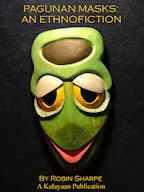Most skull face masks were made of seaweed, which was molded and dried in the sun. Bloughart has described the process and claimed thousands were made for a bacchanal. None of the seaweed ones have survived, indeed few would have survived more than a week or so, they were disposable and, incidentally, biodegradable. Probably only after the introduction of steel blades were some of these masks worn by performers carved out of darle. Interestingly, the darle masks may have been carved to look like the seaweed ones rather than a real skull. They were also typically, like the one here, painted a pale green suggestive of bleached seaweed, looking as if they could have been formed by human hands and fingers pulling and squeezing them into shape. Following the form of one material in another has a long history. Classic Greek buildings in marble, the Parthenon for example, copied the beam end detail of earlier timber structures.

